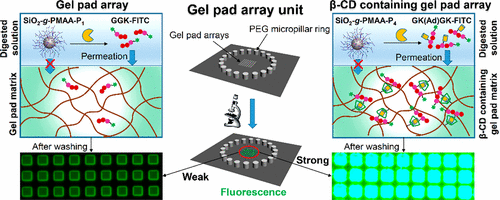当前位置:
X-MOL 学术
›
ACS Biomater. Sci. Eng.
›
论文详情
Our official English website, www.x-mol.net, welcomes your feedback! (Note: you will need to create a separate account there.)
Rational Design of Peptide-Functionalized Poly(Methacrylic Acid) Brushes for On-Chip Detection of Protease Biomarkers
ACS Biomaterials Science & Engineering ( IF 5.8 ) Pub Date : 2017-09-12 00:00:00 , DOI: 10.1021/acsbiomaterials.7b00584 Yeping Wu 1, 2, 3 , Muhammad Naeem Nizam 1, 2, 3 , Xiaokang Ding 1, 2, 3 , Fu-Jian Xu 1, 2, 3
ACS Biomaterials Science & Engineering ( IF 5.8 ) Pub Date : 2017-09-12 00:00:00 , DOI: 10.1021/acsbiomaterials.7b00584 Yeping Wu 1, 2, 3 , Muhammad Naeem Nizam 1, 2, 3 , Xiaokang Ding 1, 2, 3 , Fu-Jian Xu 1, 2, 3
Affiliation

|
There is an increasing demand for developing new materials and approaches for rapid and sensitive detection of protease biomarkers. Herein, the poly(methacrylic acid) (PMAA) brushes were synthesized from silica nanoparticles via surface-initiated atom transfer radical polymerization (ATRP), and flexibly functionalized with different fluorescein-labeled peptides, serving as the substrates for protease assay. To facilitate the point-of-care detection of protease, polyacrylamide gel pad arrays were fabricated to allow permeation of fluorescein-labeled peptide fragments cleaved from the PMAA brushes. This experimental setup enables an on-chip protease assay with an adequate limit of detection (LOD) for detecting trypsin in a buffer solution (3.9 pM) or in serum (1.4 nM) and good specificity for differentiation of trypsin and chymotrypsin. By using this experimental setup, matrix metalloproteinase-2 and matrix metalloproteinase-9 can be detected with LODs of 2.5 nM and 3.3 nM, respectively. Moreover, by introducing an adamantine (Ad) motif to the side-chain of the peptide fragment and β-cyclodextrin (β-CD) groups to the gel pad matrix, a 2.2-fold lower LOD was achieved for the detection of trypsin (1.8 pM) due to the supramolecular self-assembly of Ad and β-CD. Given the advances in the ease of sample handling, this rational design of peptide-functionalized PMAA brushes could be useful for on-chip detection of protease biomarkers or the screening of potential protease inhibitors.
中文翻译:

用于蛋白酶生物标记物芯片检测的肽基官能化聚(甲基丙烯酸)刷的合理设计
对开发用于快速和灵敏地检测蛋白酶生物标志物的新材料和方法的需求不断增长。本文中,聚(甲基丙烯酸)(PMAA)刷是通过表面引发的原子转移自由基聚合(ATRP)由二氧化硅纳米粒子合成的,并用不同的荧光素标记肽灵活功能化,用作蛋白酶测定的底物。为了方便即时检测蛋白酶,制造了聚丙烯酰胺凝胶垫阵列,以允许从PMAA刷上切割的荧光素标记的肽片段渗透。此实验设置可实现片上蛋白酶测定,具有足够的检出限(LOD),可检测缓冲液(3.9 pM)或血清(1.4 nM)中的胰蛋白酶,并且对胰蛋白酶和胰凝乳蛋白酶的分化具有良好的特异性。通过使用此实验设置,可以分别以2.5 nM和3.3 nM的LOD检测基质金属蛋白酶2和基质金属蛋白酶9。此外,通过在肽片段的侧链上引入金刚烷(Ad)基序,并在凝胶垫基质上引入β-环糊精(β-CD)基团,检测胰蛋白酶的LOD降低了2.2倍(1.8 pM)是由于Ad和β-CD的超分子自组装。鉴于样品处理简便性的进步,这种肽功能化PMAA刷的合理设计可用于片上检测蛋白酶生物标志物或筛选潜在的蛋白酶抑制剂。通过在肽片段的侧链上引入金刚烷(Ad)基序,并向凝胶垫基质中引入β-环糊精(β-CD)基团,检测胰蛋白酶(1.8 pM)的LOD降低了2.2倍由于Ad和β-CD的超分子自组装。鉴于样品处理简便性的进步,这种肽功能化PMAA刷的合理设计可用于片上检测蛋白酶生物标志物或筛选潜在的蛋白酶抑制剂。通过在肽片段的侧链上引入金刚烷(Ad)基序,并向凝胶垫基质中引入β-环糊精(β-CD)基团,检测胰蛋白酶(1.8 pM)的LOD降低了2.2倍由于Ad和β-CD的超分子自组装。鉴于样品处理简便性的进步,这种肽功能化PMAA刷的合理设计可用于片上检测蛋白酶生物标志物或筛选潜在的蛋白酶抑制剂。
更新日期:2017-09-12
中文翻译:

用于蛋白酶生物标记物芯片检测的肽基官能化聚(甲基丙烯酸)刷的合理设计
对开发用于快速和灵敏地检测蛋白酶生物标志物的新材料和方法的需求不断增长。本文中,聚(甲基丙烯酸)(PMAA)刷是通过表面引发的原子转移自由基聚合(ATRP)由二氧化硅纳米粒子合成的,并用不同的荧光素标记肽灵活功能化,用作蛋白酶测定的底物。为了方便即时检测蛋白酶,制造了聚丙烯酰胺凝胶垫阵列,以允许从PMAA刷上切割的荧光素标记的肽片段渗透。此实验设置可实现片上蛋白酶测定,具有足够的检出限(LOD),可检测缓冲液(3.9 pM)或血清(1.4 nM)中的胰蛋白酶,并且对胰蛋白酶和胰凝乳蛋白酶的分化具有良好的特异性。通过使用此实验设置,可以分别以2.5 nM和3.3 nM的LOD检测基质金属蛋白酶2和基质金属蛋白酶9。此外,通过在肽片段的侧链上引入金刚烷(Ad)基序,并在凝胶垫基质上引入β-环糊精(β-CD)基团,检测胰蛋白酶的LOD降低了2.2倍(1.8 pM)是由于Ad和β-CD的超分子自组装。鉴于样品处理简便性的进步,这种肽功能化PMAA刷的合理设计可用于片上检测蛋白酶生物标志物或筛选潜在的蛋白酶抑制剂。通过在肽片段的侧链上引入金刚烷(Ad)基序,并向凝胶垫基质中引入β-环糊精(β-CD)基团,检测胰蛋白酶(1.8 pM)的LOD降低了2.2倍由于Ad和β-CD的超分子自组装。鉴于样品处理简便性的进步,这种肽功能化PMAA刷的合理设计可用于片上检测蛋白酶生物标志物或筛选潜在的蛋白酶抑制剂。通过在肽片段的侧链上引入金刚烷(Ad)基序,并向凝胶垫基质中引入β-环糊精(β-CD)基团,检测胰蛋白酶(1.8 pM)的LOD降低了2.2倍由于Ad和β-CD的超分子自组装。鉴于样品处理简便性的进步,这种肽功能化PMAA刷的合理设计可用于片上检测蛋白酶生物标志物或筛选潜在的蛋白酶抑制剂。



























 京公网安备 11010802027423号
京公网安备 11010802027423号